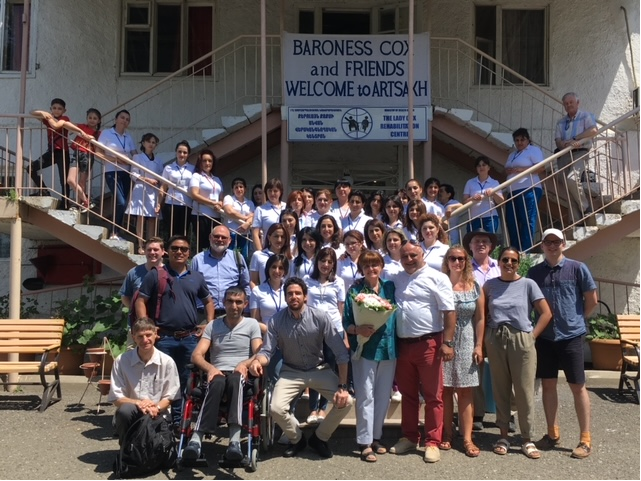War in Nagorno Karabakh: A story of hope amidst the ashes of destruction

Christmas is a time when we pray for light and hope to emerge in areas affected by violence and hardship.
In the small Armenian territory of Nagorno Karabakh (known as Artsakh to its Armenian residents) there exists a wonderful symbol of life and hope that has emerged from the destruction of two brutal wars that took place there in 1988-1994 and in 2020.
HART's partner in Nagorno Karabakh, the Lady Cox Rehabilitation Centre
During the Nagorno Karabakh war of 1988-1994, it is estimated that about 50,000 people were wounded. Both soldiers and civilians were left disabled and lacked even the most basic medication for pain relief. In 1998, a bomb-damaged building in the capital of Nagorno Karabakh, Stepanakert, was reconstructed as the region's first and only rehabilitation facility for people with disabilities. Specialist courses for local nurses were held and in 2005, the Rehabilitation facility was re-named the Lady Cox Rehabilitation Centre.
Since then, a state of the art hydrotherapy pool has been installed, a day care centre for young children with mental and physical disabilities has opened, and a specialised sub-centre for the treatment of children with autism and cerebral palsy have been added.
These have helped secure the institution's reputation as a 'Centre of Excellence', providing physical therapy, speech therapy, hydrotherapy and psychologist sessions, that are unique to the region.
By 2021, the centre had 73 staff including 25 nurse specialists who treated 160 inpatients and almost 400 outpatients, including home visits throughout the region.
The centre's inspirational Director and Founder, Vardan Tadevosyan, told us: "For decades, I, my staff and patients have suffered the consequences of conflict in our homeland.
"But the Lady Cox Rehabilitation Centre represents the courage, resilience and spirit of our people and is a symbol of light and hope for the people of Nagorno Karabakh and the whole region.
"Throughout the pandemic and at the start of the 2020 conflict, the centre continued to provide the best possible care for their disabled patients, until the scale of the conflict forced the centre's temporary evacuation."
Vardan has proved innovative in breaking many of the entrenched Soviet stigmas surrounding disability. While children with physical or mental handicaps have often been segregated, his nursery embraces children with and without disabilities who serve as path-breaking examples of integration.
He has also broken the Soviet prejudice against the employment of people with disabilities, initially employing, for example, a blind psychologist for telephone counselling.
He says: "We are proud to have transformed the lives of people with disabilities, who would otherwise have been isolated and neglected, both those paralysed and injured by war, and those with inherited or accidental disabilities."
The Karabakh Conflict of 2020
Between 27 September and 9 November 2020, a second brutal war took place in Nagorno Karabakh.
As Vardan says: "We were subject to constant military offensives by tanks, helicopters, cluster munitions and Smerch rockets.
"These caused mass displacement with over 100,000 civilians forced to flee their homes and over 14,000 civilian structures destroyed or damaged."
Advanced drone technology and superior Turkish-backed Azerbaijani forces, assisted by several thousand Syrian jihadist militants imported by Turkey, played a significant role in leading to Armenia's defeat.
After the capture of the key strategic town of Shushi, which overlooks Nagorno Karabakh's capital, Stepanakert, Artsakh was forced to accept a Russian-brokered ceasefire and a 'peace' deal that resulted in the handover of 70 per cent of Artsakh's territory, including hundreds of Armenian religious and historical sites, back to Azeri control.
During the war, over 5,000 lives were lost on both sides and thousands lost their homes.
The social, psychological and emotional impact of this on the Armenian population of Artsakh cannot be overstated. And the scale of anti-Armenian, anti-Christian rhetoric; the denial and obliteration of Armenian heritage; and the refusal by Azerbaijan to release Armenian prisoners of war only heightens the residents' continued fear for the future.
Hope emerges from the ashes of destruction
Despite the severe and ongoing hardships of the recent conflict, the rehabilitation centre continues to flourish. It has reopened and expanded its work to accommodate injured soldiers. Needs have multiplied and the number of patients treated each year is expected to double to more than 2,000, with patients receiving physiotherapy, hydrotherapy, speech therapy and psychological treatment.
Vardan told us recently: "Despite all that has happened and the continuing uncertainty, we still mark celebrations when patients and staff come together to share fun and laughter. Patients feel valued and prioritised. Our work is centred on compassion and determination and despite all the suffering, it goes from strength to strength.
"I am very happy with the patients' progress and they love the staff and friendly environment. This year we will have 1,300 people visiting the centre. The home visit programme is three times bigger than before and we continue the kindergarten and autism centre. As for the soldiers, we don't want to put them on a waiting list. They are seen as soon as they apply. This is why my staff are working much more intensively."
Whatever the politics of war, it is always the innocent who suffer and in many places, provision for the wounded and disabled is, at best, inadequate. But for all the suffering and uncertainty in Nagorno Karabakh, the spirit of compassion and courage continues, and in the face of all odds, light and hope continue to emerge from the ashes of destruction.
Rev Dr Andrew Ashdown is Advocacy Development Manager at Humanitarian Aid Relief Trust (HART). To support the work of HART, including its support of Nagorno Karabakh's Disability Rehabilitation Centre, visit www.hart-uk.org/donate











